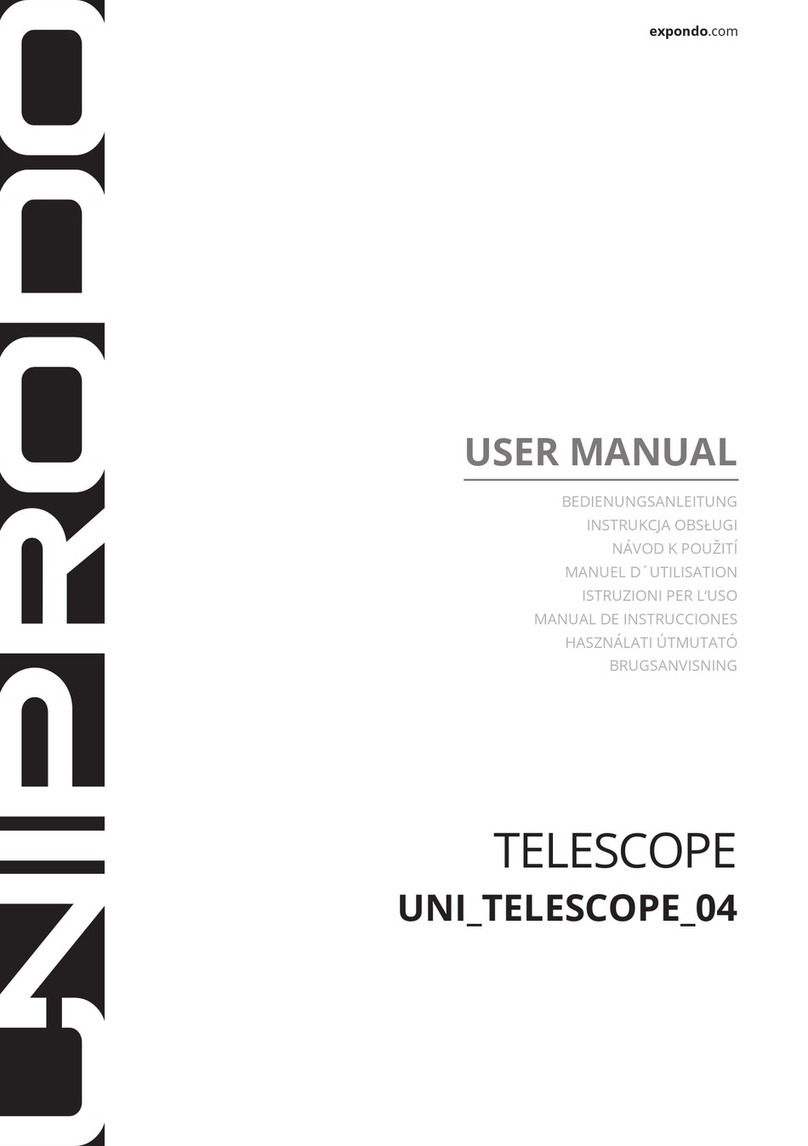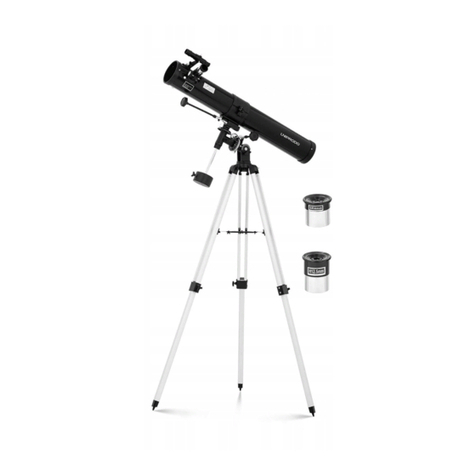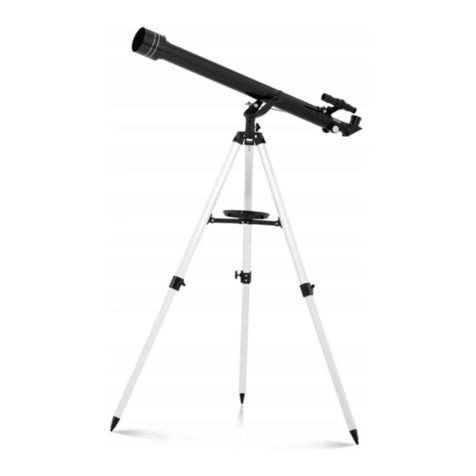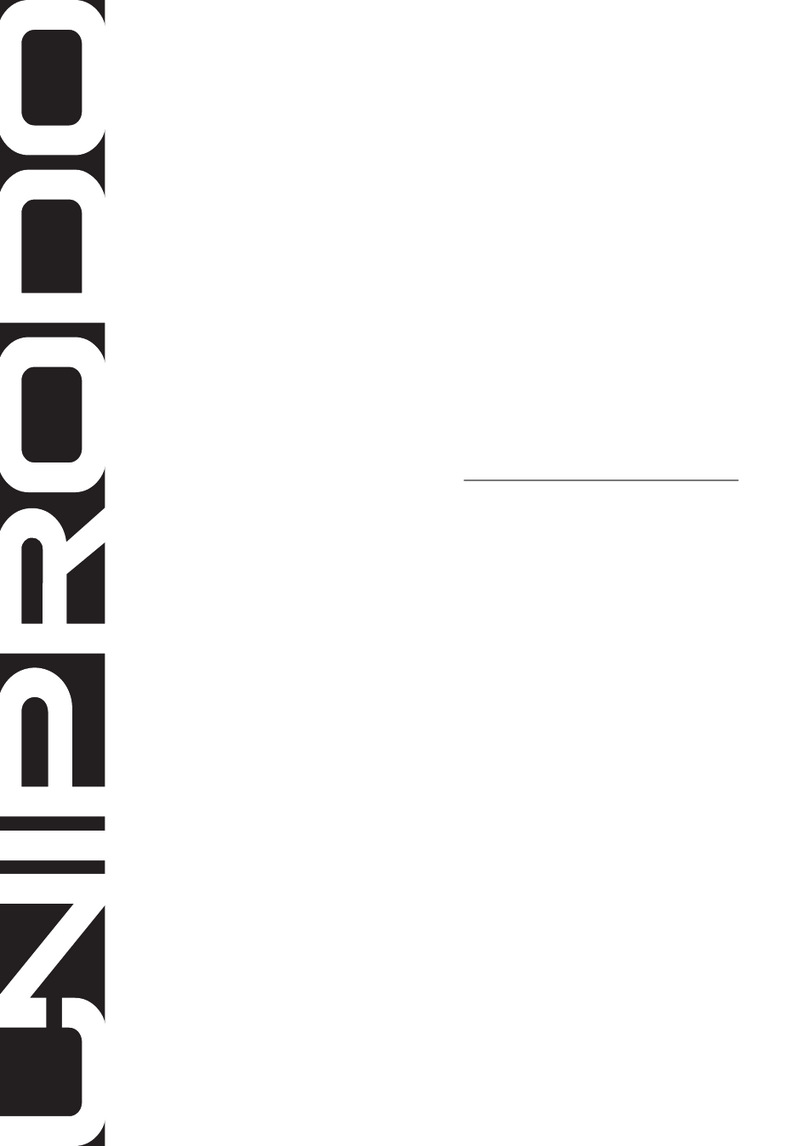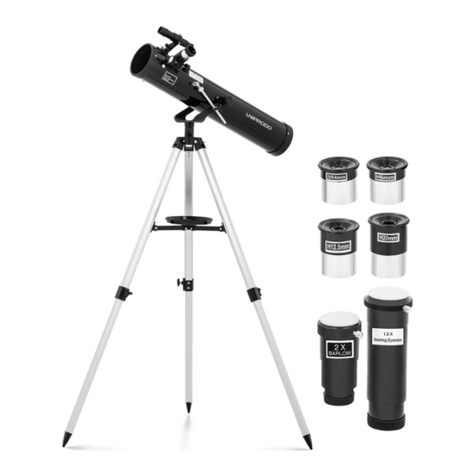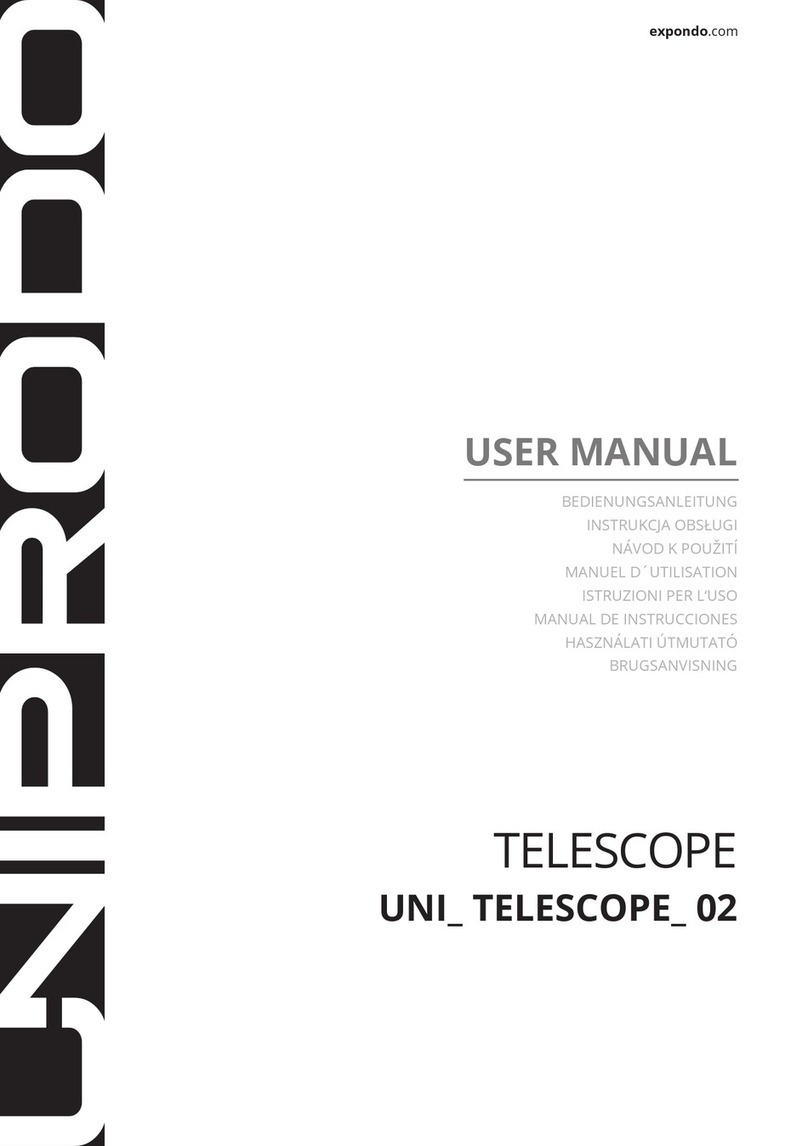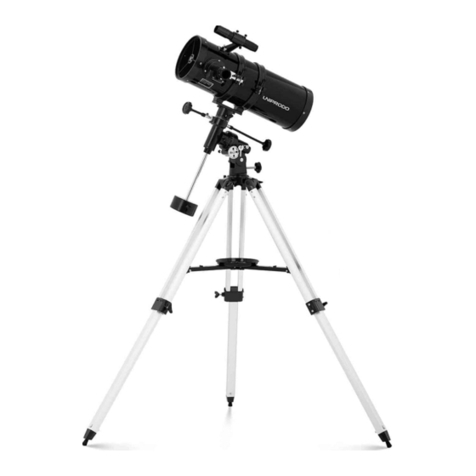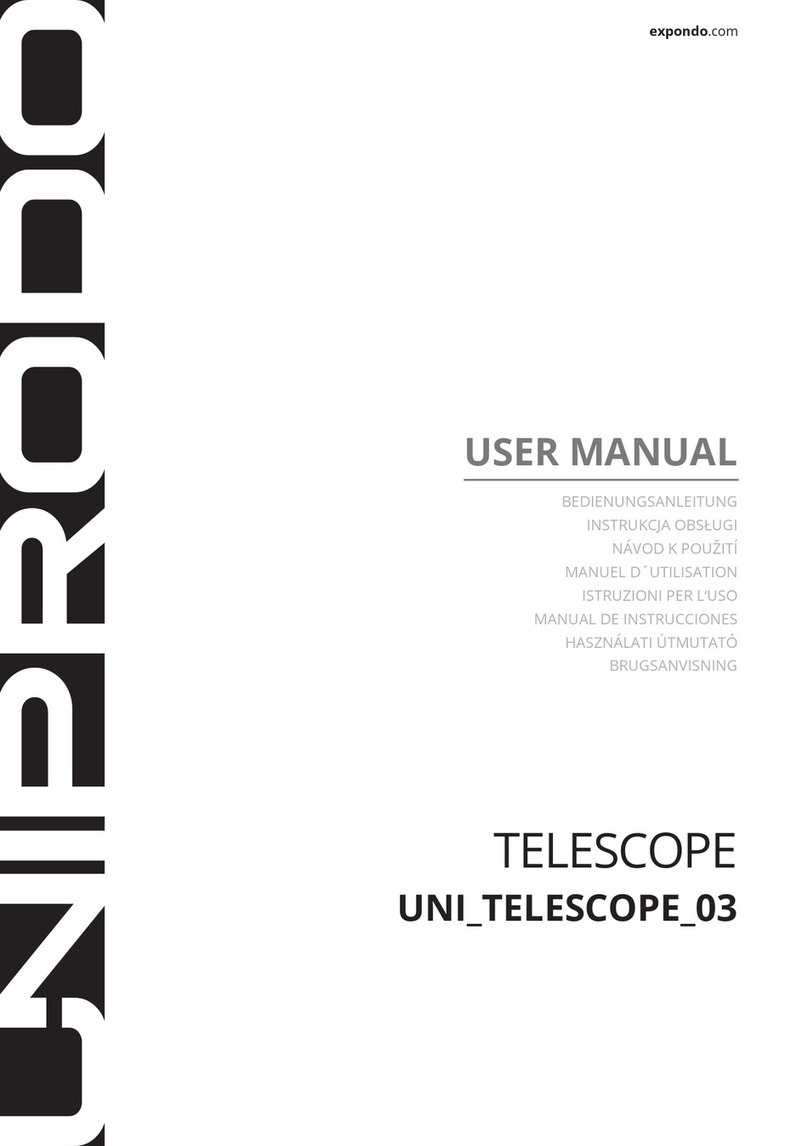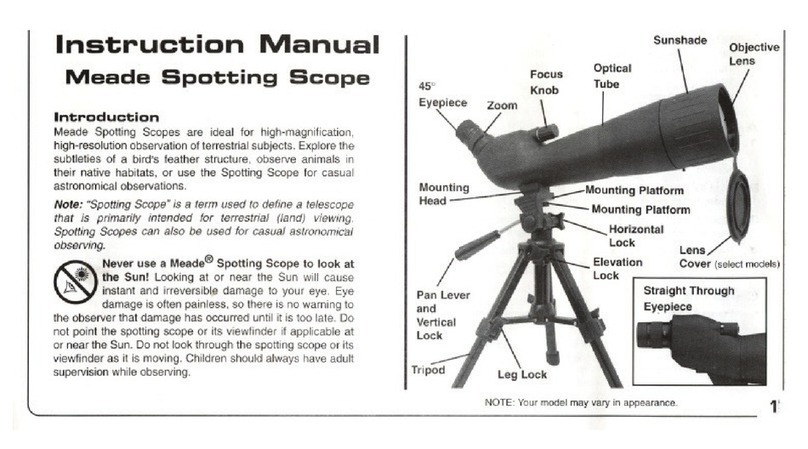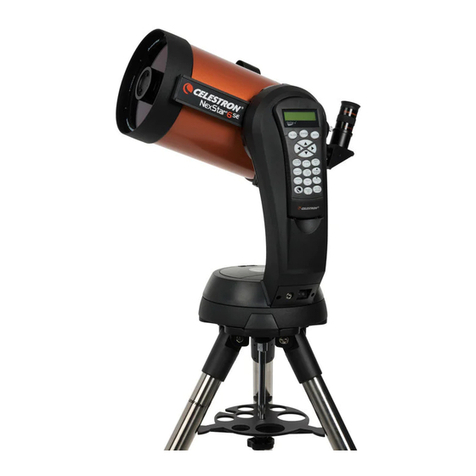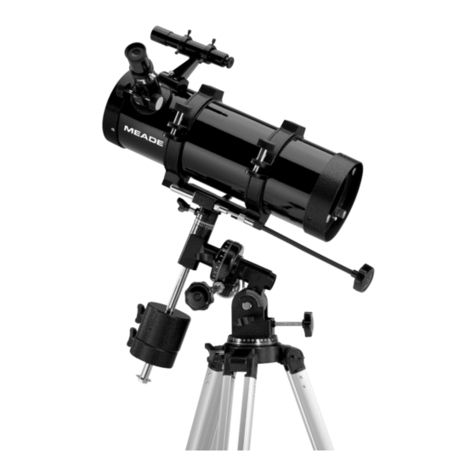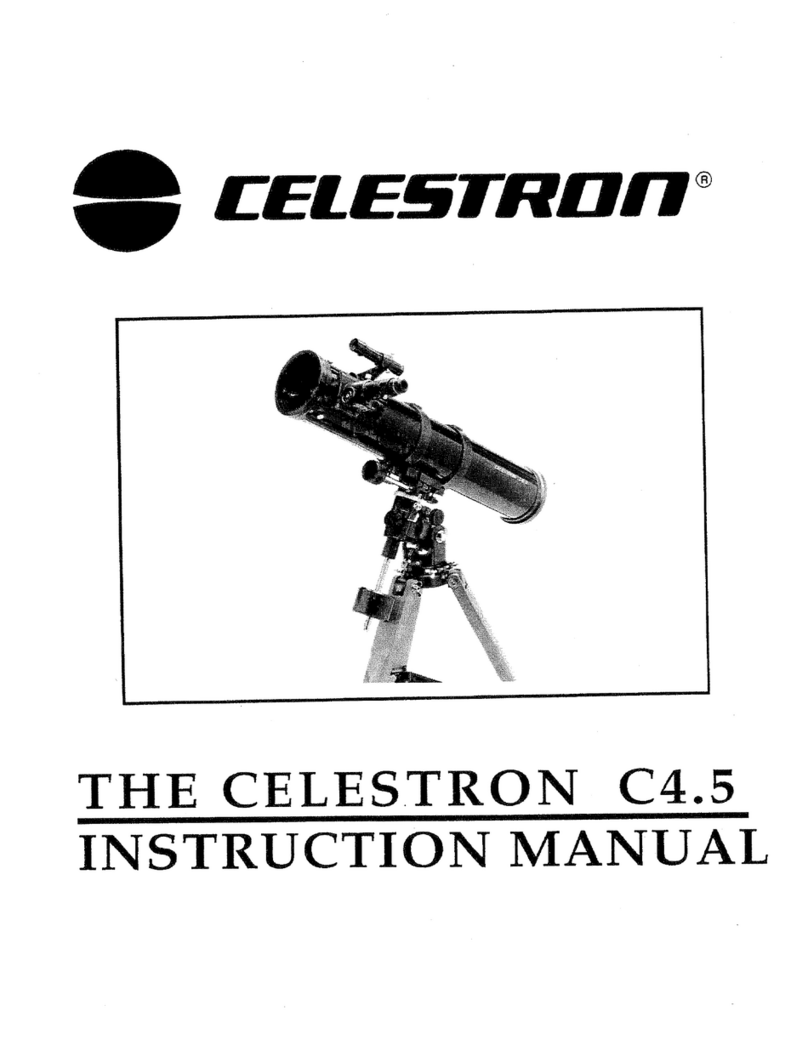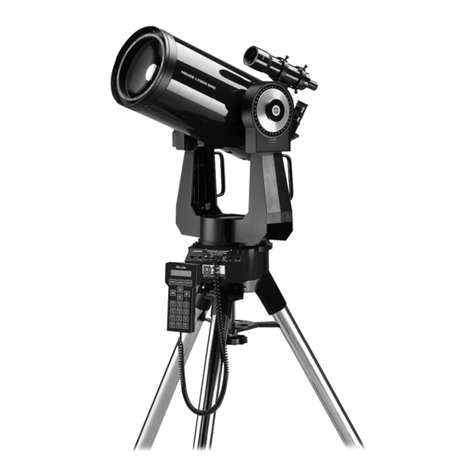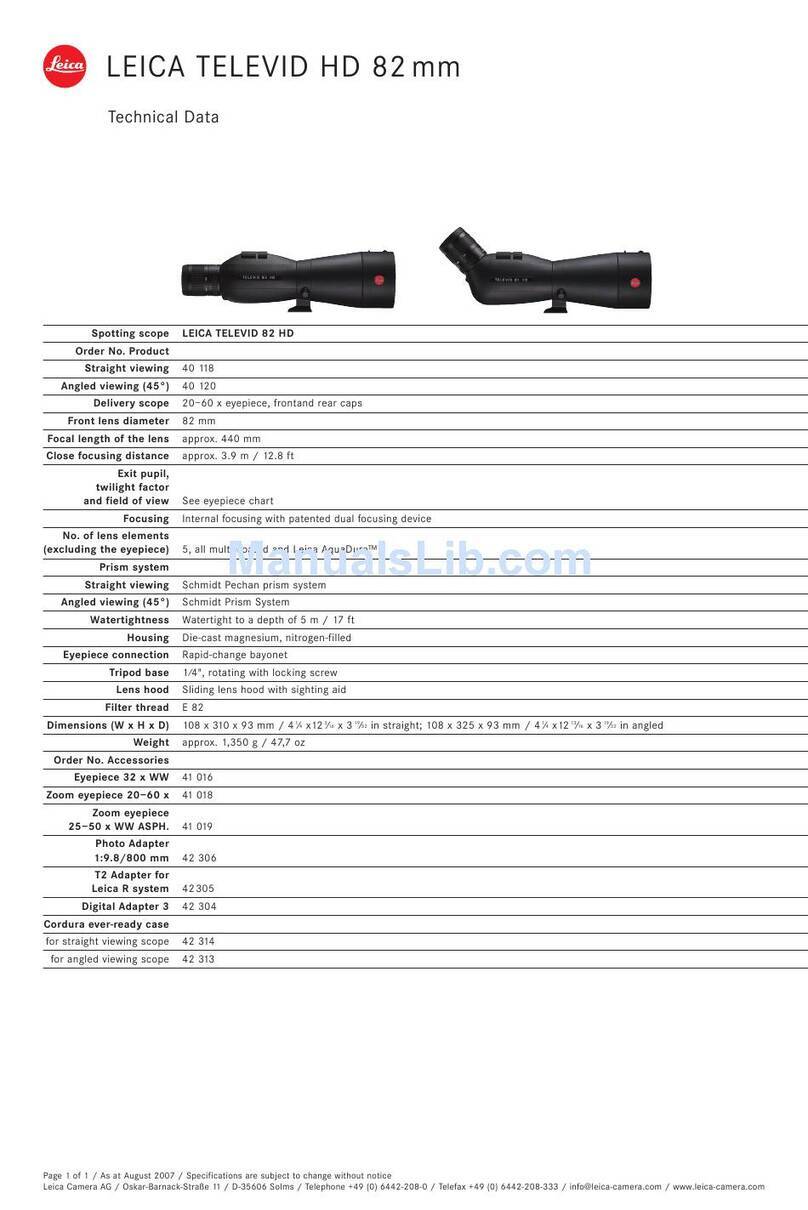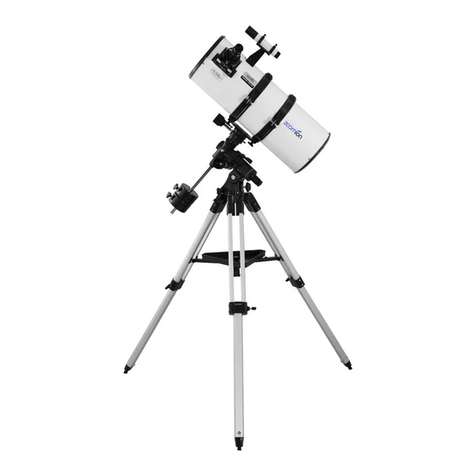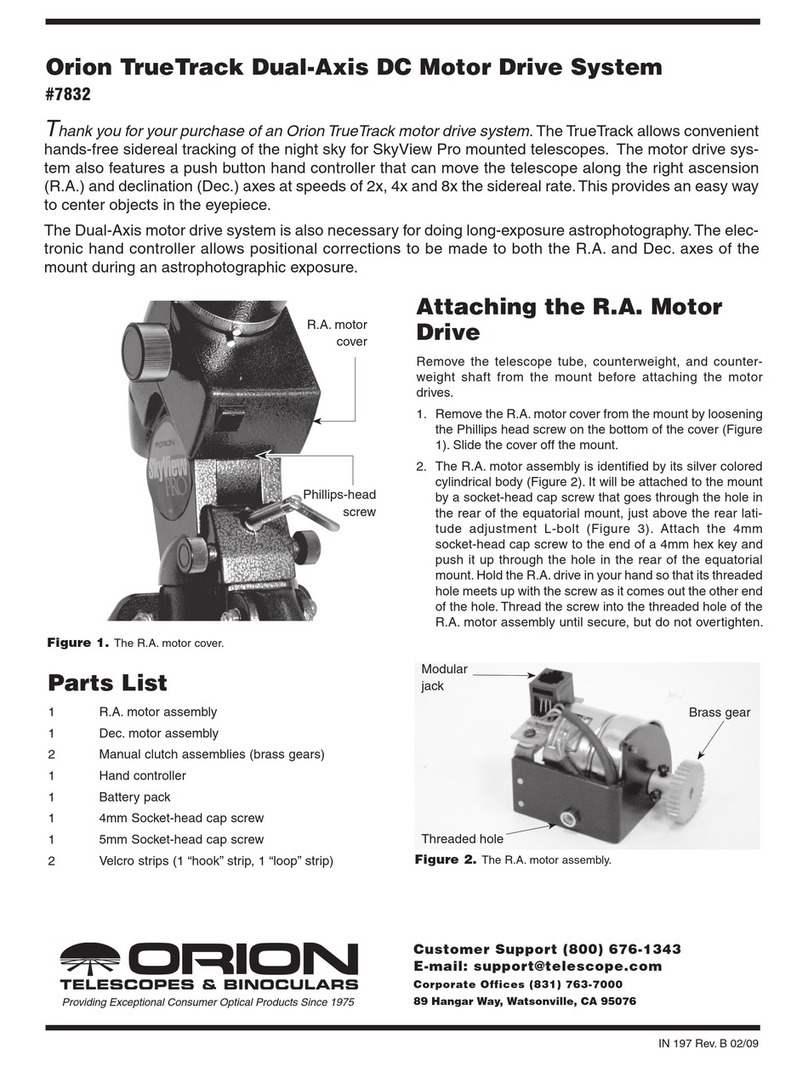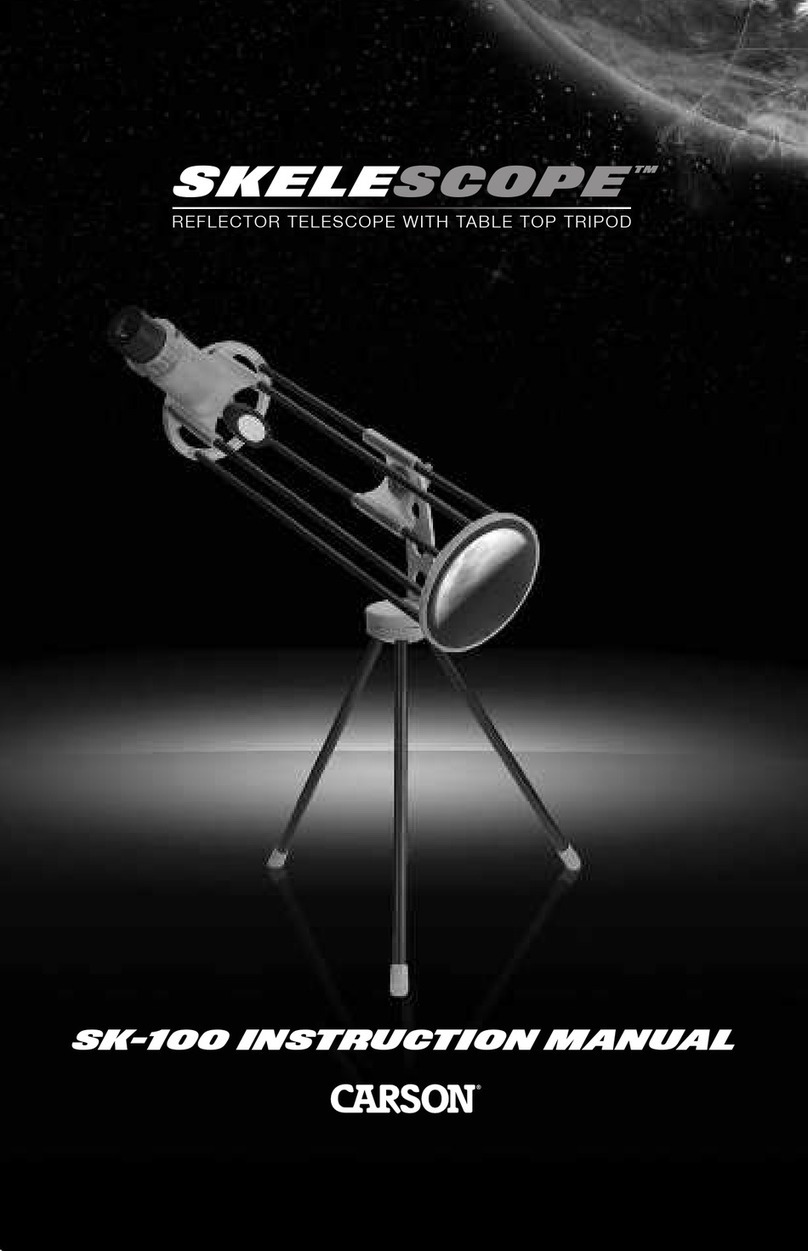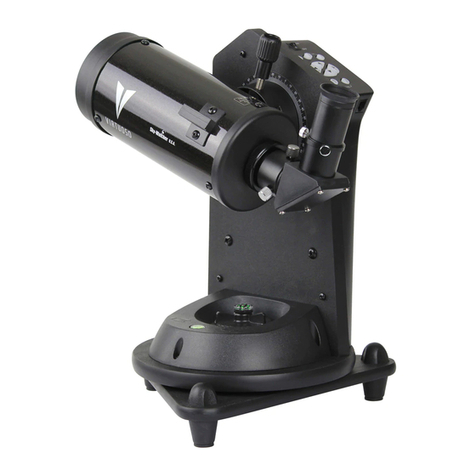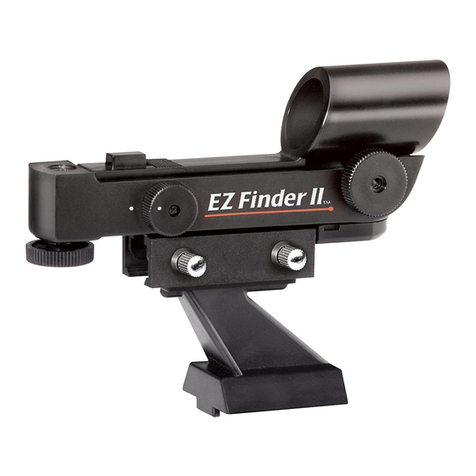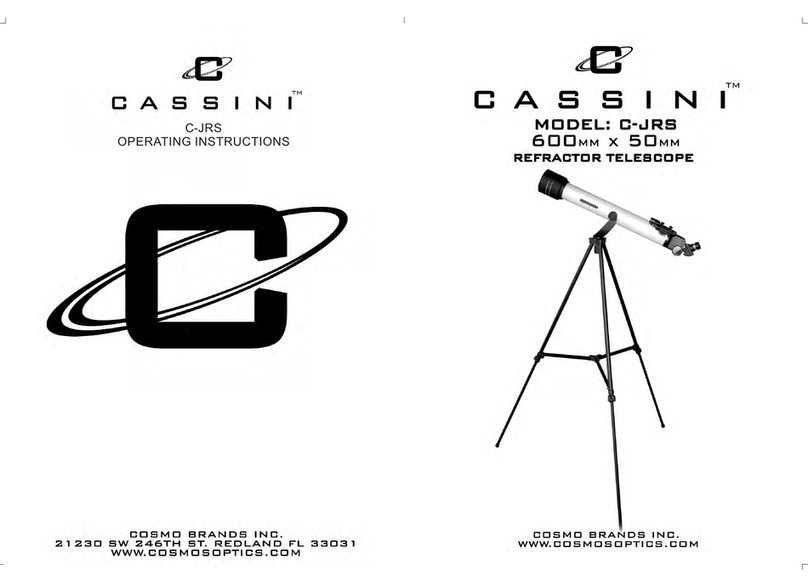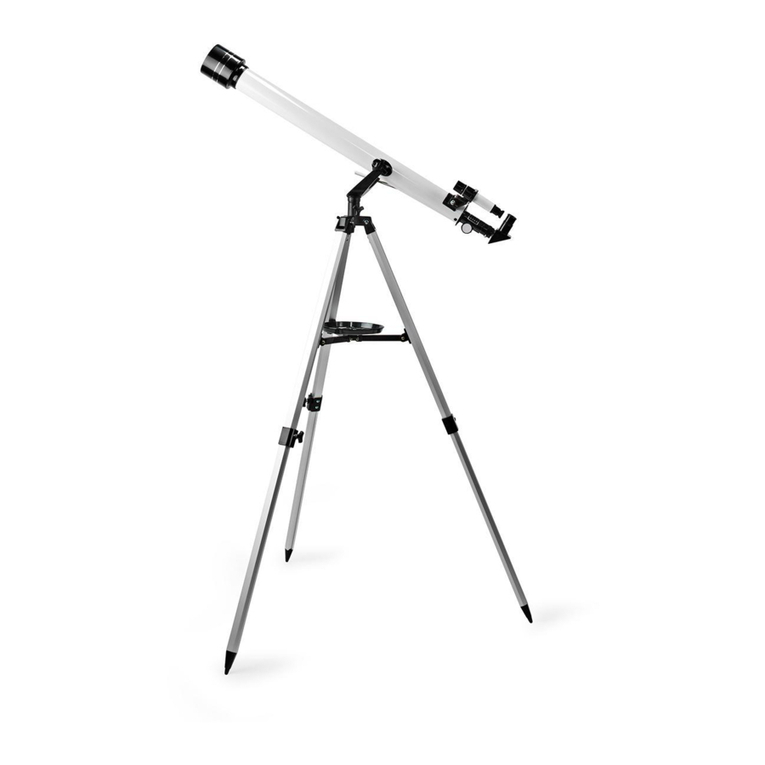
12 13
01.10.2019
FR
ISTRUZIONI PER L’USO
IT
3. Écartez le trépied, puis fixez l'étagère à accessoires
à l'aide de boulons courts et d'écrous à ailettes.
4. Suivez les instructions de montage du trépied en
aluminium, point 2-10.
MISE AU POINT DU TÉLESCOPE ET RÉGLAGE DU
CHERCHEUR
1. Desserrez les boulons lors du retrait de l'oculaire.
2. Installez l'oculaire avec le grossissement le plus
faible et fixez-le avec des boulons.
3. Pointez le télescope vers un objet éloigné.
4. Utilisez la molette de mise au point pour affiner
l'image de l'objet observé.
5. Regardez dans le chercheur. Si l'image est floue,
tournez l'oculaire jusqu'à ce que l'image soit nette.
6. Si l'objet observé dans l'oculaire du télescope
n'est pas dans le viseur du chercheur, desserrez
les boulons de fixation du chercheur, puis visez en
conséquence.
7. Répétez l'opération avec un oculaire de
grossissement plus important.
8. Une fois les opérations terminées, le télescope et
le chercheur sont réglés.
RÉGLAGE DE L'AXE POLAIRE
Avant de définir correctement l’axe polaire, vous
devez déterminer avec précision la latitude du site
d’observation.
1. Installez le télescope de nuit.
2. Desserrez le boulon de serrage de l'axe de
déclinaison [11].
3. Tournez le télescope jusqu'à ce que l'échelle de
l'axe de déclinaison indique 90°.
4. Serrez le boulon de serrage de l'axe de déclinaison
[11].
5. Desserrez le boulon de serrage de l'axe horizontal
[14].
6. Dirigez le télescope vers le nord (en direction de
l'étoile Polaire).
7. Desserrez le boulon de serrage de l'axe polaire
[24] puis réglez l'angle correspondant à la latitude.
8. Trouvez l'étoile Polaire dans l'oculaire du
chercheur. Si l'étoile Polaire n'est pas au centre du
chercheur, desserrez le boulon de serrage de l'axe
horizontal [14] et corrigez le réglage.
OCULAIRE ET GROSSISSEMENT
Le télescope est équipé de plusieurs types d'oculaires.
La puissance de chaque oculaire dépend de la distance
focale du miroir principal.
P= A
B
P. Grossissement du télescope
A. Distance focale du miroir principal
B. Distance focale de l'oculaire
FONCTIONS ET ACCESSOIRES
1. Objectif Barlow – utilisé avec l'oculaire du
télescope, il étend la distance focale du télescope
et, par conséquent, agrandit l'image de l'objet
observé.
2. Filtre lunaire – utilisé avec l'oculaire du télescope,
réduit la quantité de lumière traversant le système
optique à travers les filtres polarisants.
3. Oculaire de redressement – sert à augmenter
le grossissement avec un oculaire donné lors
des observations au sol et rétablis l'orientation
correcte de l'image de l'objet observé.
Attention: Les lentilles et les filtres doivent être
installés dans l'oculaire du côté opposé au
positionnement de l'œil.
NETTOYAGE ET ENTRETIEN
a) Pour nettoyer les différentes surfaces, n'utilisez
que des produits sans agents corrosifs.
b) Conservez l'appareil dans un endroit propre, frais
et sec, à l'abri de l'humidité et des rayons directs
du soleil.
c) Pour le nettoyage, utilisez un chiffon doux, sans
poussière ni peluche.
d) Stockez le produit dans un endroit non exposé
à des températures élevées ou basses, à la
poussière et aux agents chimiques.
1
NS18
11
12
32
24
14
DATI TECNICI
Parametri -
Descrizione
Parametri - Valore
Nome del prodotto Telescopio
Modello UNI_TELESCOPE_08
Apertura [mm] 114
Focale 1000
Cercatore 5x24
Dimensioni [mm] 420x210x1490 (verticalmente)
Peso [kg] 9,05
a) È vietato guardare direttamente una sorgente
luminosa attraverso la lente. Questo può causare
danni agli occhi e crisi epilettiche.
b) È vietato lasciare la lente d'ingrandimento
incustodita in luoghi esposti alla luce solare
diretta, poiché ciò crea un pericolo d'incendio.
Dopo aver terminato il lavoro, è necessario
ricordarsi di chiudere la copertura della lente.
c) È vietato dirigere il raggio di luce focalizzato verso
persone o animali. Ciò potrebbe causare ustioni.
d) Non utilizzare il prodotto in un ambiente instabile
al fine di evitare eventuali danni agli occhi.
CONDIZIONI D'USO
Il prodotto è progettato per l'osservazione di oggetti
situati ad un' ampia distanza dall'utente e per le
osservazioni astronomiche.
L'operatore è responsabile di tutti i danni derivanti
da un uso improprio.
DESCRIZIONE DEL DISPOSITIVO
1. Apertura
2. Specchio secondario
3. Viti di montaggio del supporto del cercatore
4. Cercatore
5. Supporto del cercatore
6. Oculare del cercatore
7. Tubo principale
8. Manopola di messa a fuoco
9. Tubo di messa a fuoco
10. Estrattore dell’oculare
11. Vite di serraggio della declinazione
12. Vite di serraggio dell’ascensione retta
13. Meccanismo orario
14. Vite di serraggio dell’asse orizzontale
15. Vite di serraggio del treppiede
16. Piedini in gommma
17. Tubo flessibile di controllo della declinazione
18. Asse polare
19. Ripiano per accessori
20. Supporto del ripiano per accessori
21. Treppiede
22. Specchio primario
23. Vite ausiliaria dell’asse polare
24. Vite di serraggio dell'asse polare
25. Vite di montaggio del cercatore
26. Morsa
27. Fissaggio della declinazione
ATTENZIONE: L´esploso di questo prodotto si trova
nell´ultima pagina del manuale d´uso, p. 17.
28. Manopola per la impostazione dell’ angolo orario
29. Manopola di declinazione
30. Tubo flessibile di controllo dell’ascensione retta
31. Fissaggio dell’ascensione retta
32. Scala della latitudine
33. Albero di contrappeso
34. Contrappeso
35. Oculare (non mostrato nella figura)
36. Filtro lunare (non mostrato nell’illustrazione)
MONTATURA
Treppiede in alluminio
1. Estrarre il treppiede dall'imballaggio, regolare
la lunghezza e la distanza delle gambe, quindi
bloccare le impostazioni con le viti di serraggio.
2. Montare il ripiano per accessori sul supporto e
fissarlo con la vite di serraggio.
3. Estrarre la montatura dall'imballaggio. Allentare
le viti del meccanismo. Installare la montatura
sul treppiede e fissarlo con la vite di serraggio
dell'asse orizzontale.
4. Avvitare la vite ausiliaria dell'asse polare.
5. Fissare i fili sul lato piatto della chiocciola in modo
che siano collegati tra loro, quindi serrare con la
vite di serraggio.
6. Posizionare il contrappeso sull'albero del
contrappeso, quindi installare l'unità completa
sulla montatura e fissare con la vite di fissaggio.
7. Rimuovere la staffa dal tubo, quindi fissare la
staffa di bloccaggio alla montatura con una vite e
una chiave a brugola.
8. Inserire il tubo nella staffa di fissaggio e fissarlo
con la vite di fissaggio.
9. Installare l'adattatore dell' oculare e il tubo di
messa a fuoco, fissare con la vite di serraggio.
10. Installare il supporto del cercatore sulla superficie
del tubo principale e fissarlo con le viti.
Treppiede in legno
1. Estrarre il treppiede dall'imballaggio, regolare
la lunghezza e la distanza delle gambe, quindi
bloccare le impostazioni con le viti di serraggio.
2. Fissare ogni piede del treppiede alla base di
montatura utilizzando un bullone lungo e un dado
ad alette,
3. Distanziare le gambe del treppiede, quindi fissare
il ripiano per accessori con bulloni corti e dadi ad
alette.
4. Seguire le istruzioni per l'installazione del
treppiede in alluminio, punti 2-10.
